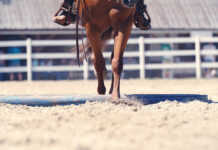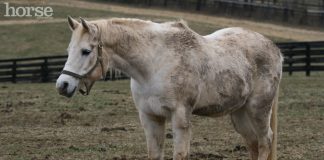Q: My 5-year-old gelding recently came up lame, and the vet diagnosed him with a bone cyst in the right front foot, between his navicular and coffin bones. He has only been in regular work (including jumping) for the last six months, but this was the first time it caused a problem. Is it likely to affect the rest of his performance career, or can something be done to help it?

A: The term “cyst” is a misnomer; it means there is a “closed sac, having a distinct lining that is filled with fluid or air.” Bone cysts should be more appropriately called cyst-like lesions and are often referred to as subchondral bone cysts, as they are a disruption of the bone just beneath the cartilage within a joint.
Most commonly, bone cysts are a result of a developmental defect that occurred early in a horse’s life as the bone formed. Large-boned, fast-growing horses can have abnormal growth and mineralization of the cartilage that lines the joint surface. This can lead to defects in the deep layers of cartilage, and abnormalities of the cartilage within the joint. Imbalances in the calcium-phosphorus ratio of a young horse’s diet, as well as deficiencies in copper and excesses in zinc concentrations, can also cause these developmental abnormalities. Large lesions will cause lameness early in a horse’s life; however, smaller, more subtle changes will not cause a problem until the animal is in work, which is likely the case with your horse. The mechanical trauma of regular exercise will cause disruption of the improperly formed cartilage. Joint inflammation, cracks in the cartilage (arthritis) and even microfractures of the underlying bone can all occur with subchondral cysts.
Bone cysts are mainly diagnosed with radiographs. Equine sports medicine experts also use magnetic resonance imaging (MRI) to diagnose bony problems, as well as injuries to the delicate surrounding tendons and ligaments. There may be multiple pathologies causing the lameness that cannot be seen on radiographs alone.
Treatment of cyst-like lesions is mainly based on reducing the inflammation caused by the associated arthritis in the joint. Stall rest may allow the inflammation to quiet down, and can be an effective treatment in young horses. In older horses with concurrent osteoarthritis, rest has only limited success.
Ensuring that your horse is properly shod can also have an impact on his soundness; long toes and under-run heels can exacerbate lameness. Toe length can be shortened, and wedge pads can compensate for low heels.
Combating the inflammation within the joint will resolve the lameness in many cases. Intra-articular injections of anti-inflammatory corticosteroids and joint lubricating medications, such as hyaluronic acid, can improve joint function. These injections will improve soundness, but the treatments will need to be repeated based on your horse’s response.
Intramuscular injections of Adequan (polysulfated glycosaminoglycan) will support the health of the chondrocytes (cartilage cells), preventing further degeneration and improving the health of the joint. Surgical procedures do exist to treat cyst-like lesions and smooth out the arthritic changes seen on the cartilage, but they’re not always appropriate for every case.
Unfortunately, once cyst-like lesions associated with lameness are identified, there is little that can be done to cure them or reverse the arthritic changes that come with them. Being in tune with your horse’s comfort level and working closely with your veterinarian are the keys to a long and sound career for you and your horse.
Joan Norton, VMD, DACVIM, is the founder of Norton Veterinary Consulting and Education Resources, a firm dedicated to the education of horsemen and equine veterinarians through internal medicine consultations, lectures, webinars and writing. More information on her services and courses can be found at www.nortonveterinaryconsulting.com.
This article originally appeared in the November 2013 issue of Horse Illustrated. Click here to subscribe.





